Madagascar: an innovative relief project offers hope for a sustainable future

Focusing on the remote areas of Androy and Anosy – some four hours’ drive from the capital, Antananarivo – WFP’s Rapid Rural Transformation initiative provides solar power stations, sustainable water sources and digital health checksin partnership with governments.
The benefits for the regions are multiple and welcome: energy, water and digital platforms, all provided in an environmentally responsible and sustainable way, the UN agency said.
Power up
Equally important, the project is coming from promote the growth of plants, while addressing the most pressing needs of rural communities. If successful, WFP plans to take the scheme to other villages and regions.
“With this pilot project, we will facilitate rural transformation even in remote areasthrough the provision of clean water for irrigation, the operation of health facilities, the expansion of business opportunities, and the development of their agricultural value chains,” said Jocelyn Raharimbola, Governor of Anosy region.
“After years of food insecurity, data on the ground shows improvement in the nutritional situation thanks to emergency interventions and collaboration with companies according to WFP.
The initiative is managed by local authorities and allows partners to provide additional services as well business training for women and youth members of society.
There are online classes on sustainability, business skills and farming, which are enhanced by easily installed solar drip irrigation and hydroponics systems. The plan environmental responsibility and a sustainable approach is a “game changer”, maintained Tomson Phiri, WFP Regional Communications Lead and Spokesperson for Southern Africa.
The sun is abundant
“If there is one thing that the people of the south have, it is the abundance of sunlight; it’s hot, it’s dry… we’ve built solar-powered stations that will provide a sustainable source of water to the places I’ve visited, we’ve introduced ICT (Information Communication Technology) in these remote areas, allowing for the provision of important work is energy, green energy, is water, and digital platforms to members of the community. “
Mr. Phiri, speaking via Zoom from the capital, Antananarivo, told reporters in Geneva that while it was hurricane season in the north, the south was experiencing drought conditions.
Food insecurity is a constant threat, the WFP spokesperson continued, with 2.2 million people in the southern and south-eastern regions of Madagascar facing high levels of food insecurity during the harvest season between now and April 2023.
The combined effects of drought, COVID-19 and rising insecurity have undermined the already fragile food security and nutritional status of the population of southern Madagascar.
Mr Phiri said the hubs provide digital classrooms for students: “I see young people, dreams are nurtured there, I meet people, we also light up arts centres. I saw a welder starting to use solar energy for his own company, I saw a hair salon, I saw an area where technology is coming together.”
An impossible record
Madagascar is one of the 10 most vulnerable countries to disasters in the world and is considered to be the most hurricane-prone country in Africa, according to the WFP.
The UN agency added that there are Androy and Anosy regions ending the climate crisis and have high rates of chronic malnutrition among children under five.
The Rapid Rural Transformation (RRT) initiative combines two climate risk reduction strategies to help people: better management of natural resources through agricultural improvements to protect food production and diversify their livelihoods to withstand shocks the weather.
The UN WFP is the world’s largest humanitarian organization saving lives in emergencies and using food aid to build a path to peace, stability and prosperity for people recovering from conflict, disasters, and the effects of climate change. .







